International Toy Fair Nuremberg 2008
Internationale Spielwarenmesse Nürnberg 2008
| x |
|
|
|
|
|
|
|
|
|
|
|
|
|
|
|
|
|
|
|
|
|
|
|
|
|
|
|
|
|
|
|
|
| Phalanx Games |
| x |
|
|
|
|
|
|
|
|
|
|
|
|
|
|
|
|
|
|
|
|
|
|
|
|
|
|
|
|
|
|
|
|
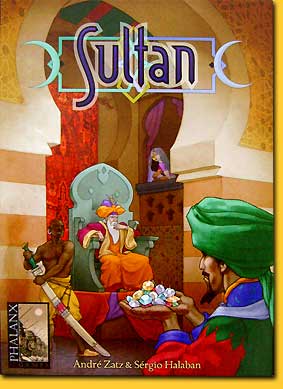 |
|
The guys who were responsible for 'Hart an der Grenze' (Kosmos), made another swift bluffing game.
The sultan has a daughter to marry, and the lucky one will be the one who is the keenest in trading at the local bazar.
All players have their own set of cards, with a value of 1 to 15. These are shuffled, and the first five are taken in the hand. Then, the starting player blindly takes four jewels from a bag, takes one back in the bag (own choice), and places the others, one each, in the three bazars.
|
|
| x |
|
|
|
|
|
|
|
|
|
|
|
|
|
|
|
|
|
|
|
|
|
|
|
|
|
|
|
|
|
|
|
|
| Now players choose one card, and place it face down next to one of the bazars. After this, all cards are turned face up. Jewels in bazars that have only one card go to that player; when in a bazar more cards are played the highest played value gets the jewel, and if there still is a tie, the first played card. |
|
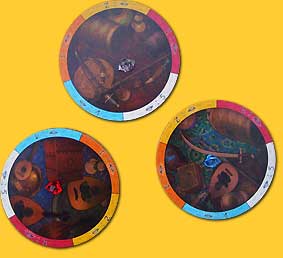 |
| x |
|
|
|
|
|
|
|
|
|
|
|
|
|
|
|
|
|
|
|
|
|
|
|
|
|
|
|
|
|
|
|
|
 |
|
After five turns, players take the next five cards from their deck on their hand and the next round begins.
After three rounds players calculate the value of their jewels, as not each jewel has an equal value. For instance: each red juwel scores one point, but each blue jewel scores five points. |
|
| x |
|
|
|
|
|
|
|
|
|
|
|
|
|
|
|
|
|
|
|
|
|
|
|
|
|
|
|
|
|
|
|
|
| Sultan, André Zatz & Sergio Halaban, Phalanx Games, 2008 - 2 to 5 players, 8 years and up, 30 minutes |
| x |
|
|
|
|
|
|
|
|
|
|
|
|
|
|
|
|
|
|
|
|
|
|
|
|
|
|
|
|
|
|
|
|
| x |
|
|
|
|
|
|
|
|
|
|
|
|
|
|
|
|
|
|
|
|
|
|
|
|
|
|
|
|
|
|
|
|
| x |
|
|
|
|
|
|
|
|
|
|
|
|
|
|
|
|
|
|
|
|
|
|
|
|
|
|
|
|
|
|
|
|
 |
| x |
|
|
|
|
|
|
|
|
|
|
|
|
|
|
|
|
|
|
|
|
|
|
|
|
|
|
|
|
|
|
|
|
| The Golden Age roughly was the period from 1600 to 1700, during which Holland was known for their successful commercial trade: the Dutch had a grain monopoly and supremacy of their trading fleet in the Baltic Sea that left them unharmed during the many food-scarcities during that century - and in effect had their inhabitants lead a high quality life. Their institutional trade with the East and West Indies through the establishment of the trading company VOC with warehouses and armies along the route left competing countries like England behind in envy. But also their scientists, one of them Van Leeuwenhoek, who invented the microscope, were internationally known and respected, not to mention the still famous painters such as Rembrandt, Jan Steen and Frans Hals. Out of this envy in the eyes of the foreign competition the Dutch were considered a nation of frogs crawled from the mud*, but their Amsterdam stock exchange was an institute that could not be skipped as here a considerate amount of international trade took place, and nobody would miss an opportunity to profit as well from their wealth. |
|
|
| * ('Holland that scarce deserves the name of land/As but th'off-scouring of the British sand.../This indigested vomit of the sea/Fell to the Dutch by just propriety.' - Andrew Marvell, 1651) |
|
|
| x |
|
|
|
|
|
|
|
|
|
|
|
|
|
|
|
|
|
|
|
|
|
|
|
|
|
|
|
|
|
|
|
|
 |
| The spices cards show different kind of spices of the new world |
| x |
|
|
|
|
|
|
|
|
|
|
|
|
|
|
|
|
|
|
|
|
|
|
|
|
|
|
|
|
|
|
|
|
In 'The Golden Age' three or four players act in a variety of fields: culture, trade, arts, investing and the like. The map board shows ten provinces with a bordered track where the king pawn moves. Most of these boxes show different provinces but there are six merchant boxes that depict a governor and the king.
On the upper left is a Guild Chart, depicting five colour coded columns that correspond with the provinces.
Around a sailing ship the activities in the West and East Indies are marked. |
|
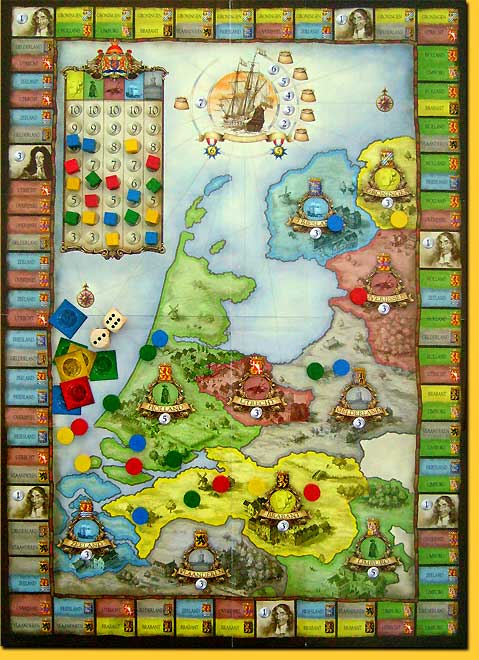 |
| x |
|
|
|
|
|
|
|
|
|
|
|
|
|
|
|
|
|
|
|
|
|
|
|
|
|
|
|
|
|
|
|
|
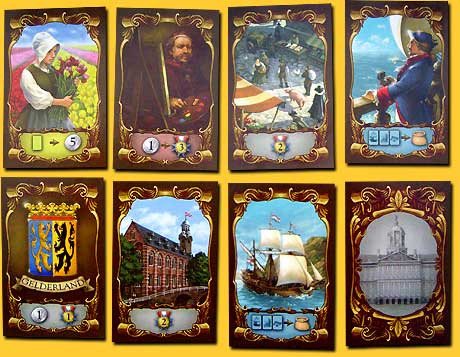 |
|
At start, each player places an influence marker in one of the provinces, and two movement tokens in any other province(s). The king pawn is placed in one of the six merchant boxes.
In his turn, a player rolls the dice and moves the king. He then may perform free actions such as moving one movement token, gaining control of a guild, or place a new influence marker. Special actions include the purchase cards or movement tokens. Auctions are conducted, after which a players victory points are totalled. When a player reaches a score of 33 points, he has won the game. |
|
| x |
|
|
|
|
|
|
|
|
|
|
|
|
|
|
|
|
|
|
|
|
|
|
|
|
|
|
|
|
|
|
|
|
Players receive income for the province where the king moved into, if they have an influence marker or movement token in that province.
Movement to any other province costs money, depending on the distance. Taking over a guild on the Guilds Chart costs a minimum of 3 guilders; converting three movement tokens into one influence marker is for free.
Influence markers are important as they entitle a player to conduct special actions, one for each influence marker on the board.
These actions include creating additional movement tokens, that cost 5 guilders each, invest in cards by paying 3 guilders for each card, or invest in arts and buy such a card. Each of these actions correspond with the colour of a province. This way it is not only important to have influence markers on the board, but also in a specific province a player wants to perform a special action.
The blue provinces (and the blue section on the Guilds Chart), for instance, allow special actions that deal with the colonies. Buying a card from this category could reveal a naval vessel, a captain, a cannon, or show the Dutch East India Company's logo, acting as a joker. As soon as a player has three of these components, he sails to the colonies and puts one marker into one of the colony boxes of his choice. At the end of his turn, such a marker would represent up to 6 victory points. |
|
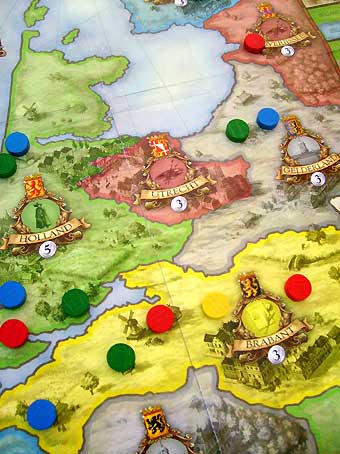 |
| x |
|
|
|
|
|
|
|
|
|
|
|
|
|
|
|
|
|
|
|
|
|
|
|
|
|
|
|
|
|
|
|
|
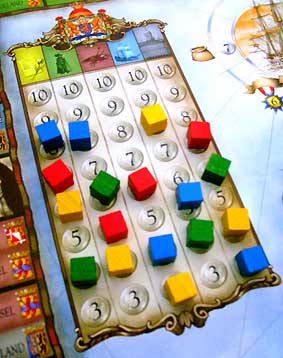 |
The grey provinces deal with cultural advancement: here windmills and governors are added to the investments, colonies, spice and arts cards.
The orange provinces deal with the spices. A player may use the boxes of the colonies to purchase spice cards, but the acquiration of such a card will cost a player a hefty seven guilders. These cards work as investment cards but guarantee a much higher average return.
As a last possible action, a player might choose not to use the special action of an influence marker, but instead auction off this special action, giving it to the player who bid the highest amount. These auctions are very important as they act as an income that immediately can be used elsewhere.
Points are given for movement tokens, influence markers, finished arts, windmills, governors, and money.
The game will have a more or less average complexity, no wargame whatsoever, but more an interesting boardgame on a topic that lies near to the roots of Phalanx Games. Needless to say, the graphics of Michael Menzel are once again top notch. |
|
| x |
|
|
|
|
|
|
|
|
|
|
|
|
|
|
|
|
|
|
|
|
|
|
|
|
|
|
|
|
|
|
|
|
| The Golden Age, Leo Colovini & Giuseppe Baù, Phalanx Games, 2008 - 3 or 4 players, no indication on age or duration |
| x |
|
|
|
|
|
|
|
|
|
|
|
|
|
|
|
|
|
|
|
|
|
|
|
|
|
|
|
|
|
|
|
|
| x |
|
|
|
|
|
|
|
|
|
|
|
|
|
|
|
|
|
|
|
|
|
|
|
|
|
|
|
|
|
 |
|
|
|
|
|
|
|
|
|
|
|
|
|
|
|
|
|
|
|
|
|
|
|
|
|
|
|
|
|
|
|
 |
|
|
|
|
|
|
|
|
|
|
|
|
|
|
|
|
|
|
|
|
|
|
|
|
|
|
|
|
|
|
|
 |
|
|
|
|
|
|
|
|
|
|
|
|
|
|
|
|
|
|
|
|
|
|
|
|
|
|
|
|
|
|
|
 |
|
|
|
|
|
|
|
|
|
|
|
|
|
|
|
|
|
|
|
|
|
|
|
|
|
|
|
|
|
|
|
 |
|
|
|
|
|
|
|
|
|
|
|
|
|
|
|
|
|
|
|
|
|
|
|
|
|
|
|
|
|
|
|
|
|
|
|
|
|
|
|
|
|
|
|
|
|
|
|
|
|
|
|
|
|
|
|
|
|
|
|
|
|
|
 |
|
|
|
|
|
|
|
|
|
|
|
|
|
|
|
|
|
|
|
|
|
|
|
 |
|
|
|
|
|
|
|
|
|
|
|
|
|
|
|
|
|
|
|
|
|
|
|
|
|